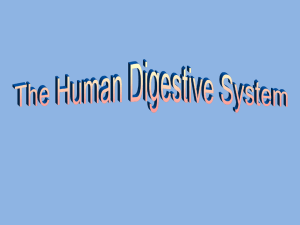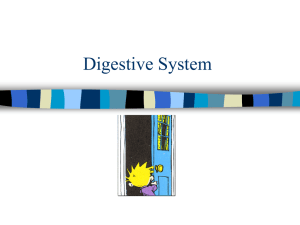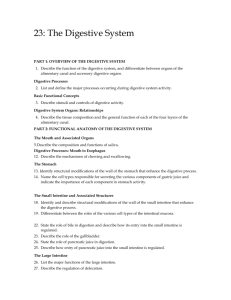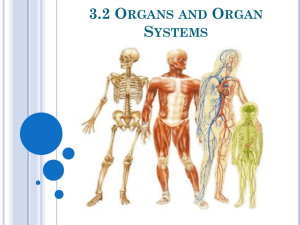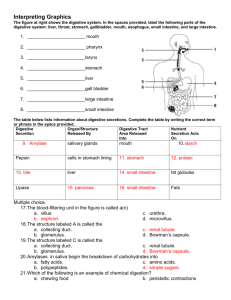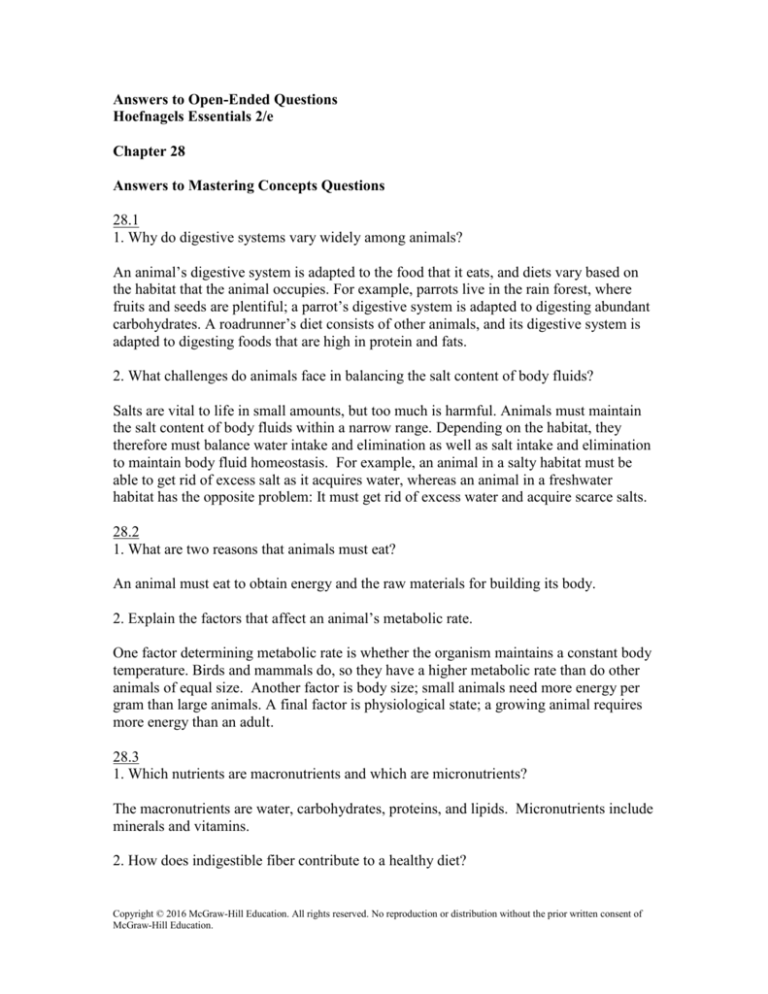
Answers to Open-Ended Questions
Hoefnagels Essentials 2/e
Chapter 28
Answers to Mastering Concepts Questions
28.1
1. Why do digestive systems vary widely among animals?
An animal’s digestive system is adapted to the food that it eats, and diets vary based on
the habitat that the animal occupies. For example, parrots live in the rain forest, where
fruits and seeds are plentiful; a parrot’s digestive system is adapted to digesting abundant
carbohydrates. A roadrunner’s diet consists of other animals, and its digestive system is
adapted to digesting foods that are high in protein and fats.
2. What challenges do animals face in balancing the salt content of body fluids?
Salts are vital to life in small amounts, but too much is harmful. Animals must maintain
the salt content of body fluids within a narrow range. Depending on the habitat, they
therefore must balance water intake and elimination as well as salt intake and elimination
to maintain body fluid homeostasis. For example, an animal in a salty habitat must be
able to get rid of excess salt as it acquires water, whereas an animal in a freshwater
habitat has the opposite problem: It must get rid of excess water and acquire scarce salts.
28.2
1. What are two reasons that animals must eat?
An animal must eat to obtain energy and the raw materials for building its body.
2. Explain the factors that affect an animal’s metabolic rate.
One factor determining metabolic rate is whether the organism maintains a constant body
temperature. Birds and mammals do, so they have a higher metabolic rate than do other
animals of equal size. Another factor is body size; small animals need more energy per
gram than large animals. A final factor is physiological state; a growing animal requires
more energy than an adult.
28.3
1. Which nutrients are macronutrients and which are micronutrients?
The macronutrients are water, carbohydrates, proteins, and lipids. Micronutrients include
minerals and vitamins.
2. How does indigestible fiber contribute to a healthy diet?
Copyright © 2016 McGraw-Hill Education. All rights reserved. No reproduction or distribution without the prior written consent of
McGraw-Hill Education.
Indigestible fiber provides bulk and eases movement of food in the digestive tract. Fiber
also reduces blood cholesterol and helps to regulate blood sugar.
28.4
1. Describe the relationship of body weight to calorie intake and energy expenditure.
If calories taken in are balanced by energy expenditure, then weight will remain constant.
If there is an imbalance, then weight will go up (excess intake) or go down (excess
expenditure).
2. What is body mass index?
Body mass index is one way to determine if a person’s weight is healthy. To calculate
BMI, divide a person’s weight in kilograms by the square of his or her height in meters.
3. Describe the events of starvation.
After day one without food, sugar and glycogen reserves are depleted, and the body
begins breaking down stored fat and muscle protein. As starvation continues over many
days and weeks, the body digests itself, deriving energy and protein from muscles,
antibodies, skin, stored fat, and bones. Death occurs when vital organ systems can no
longer function.
4. What are some of the causes and effects of obesity?
Obesity is caused by a person eating more calories than he or she uses. A diet high in
sugar and fat, combined with an inactive lifestyle, leads to obesity; genes play a role as
well. Obesity is associated with many other illnesses, including type 2 diabetes, high
blood pressure, acid reflux, urinary incontinence, stroke, and cancer.
28.5
1. Define the terms herbivore, carnivore, detritivore, and omnivore.
Herbivores eat plants. Carnivores eat other animals. Detritivores eat decomposing organic
matter. Omnivores eat a broad variety of foods.
2. What four processes does food undergo when an animal eats?
When an animal eats, food undergoes ingestion, digestion, absorption, and elimination.
3. Distinguish between intracellular and extracellular digestion.
Intracellular digestion happens in food vacuoles of individual cells. Extracellular
digestion occurs in a specialized digestive cavity; cells lining the cavity absorb the
nutrients.
Copyright © 2016 McGraw-Hill Education. All rights reserved. No reproduction or distribution without the prior written consent of
McGraw-Hill Education.
4. How do incomplete and complete digestive tracts differ?
An incomplete digestive tract has one opening (the mouth), through which an animal both
ingests food and eliminates wastes. A complete digestive tract has two openings (mouth
and anus).
5. Compare and contrast the digestive systems of an elk and a wolf.
Each digestive system reflects the animal’s diet of plants (elk) or meat (wolf). An elk is a
ruminant. It has a rumen, where microorganisms digest grass. Overall the digestive tract
is long, and the cecum is large. A wolf is a carnivore. Its digestive tract is short, and the
cecum is small.
28.6
1. Explain the action and importance of peristalsis and sphincters in digestion.
Peristalsis is the wave of muscular contraction that moves food along the digestive tract.
Sphincters are muscular rings that open and close to allow or block the passage of food
between areas of the digestive system.
2. Describe the functions of saliva, teeth, and the tongue in digestion.
Saliva moistens food and mixes it an enzyme that initiates carbohydrate breakdown. The
teeth grasp and chew food, mechanically breaking it down to increase surface area. The
tongue mixes the food with saliva and pushes the food to the back of the mouth for
swallowing.
3. How does food move from the mouth to the stomach?
The rhythmic smooth muscle contractions of peristalsis propel food along the esophagus
from the mouth to the stomach.
4. Describe the mechanical and chemical digestion that occurs in the stomach.
Mechanical digestion occurs when muscle contractions in the stomach churn and further
break up the chewed food. Chemical digestion of proteins (by pepsin) begins in the
stomach.
5. What is the structure and function of the small intestine?
The small intestine digests and absorbs the nutrients in food. It has high surface area
because the inner surface of the small intestine is folded ridges, each of which is covered
with finger-like villi. In addition, the surface of each villus has hundreds of microvilli that
greatly increase the surface area for absorption.
6. How do the pancreas, liver, and gallbladder aid digestion?
Copyright © 2016 McGraw-Hill Education. All rights reserved. No reproduction or distribution without the prior written consent of
McGraw-Hill Education.
The pancreas secretes the majority of the digestive enzymes and the bicarbonate that
neutralizes stomach acid in the intestine. The liver produces bile that emulsifies fats, and
the gallbladder stores and releases the bile.
7. Describe the events that occur as food passes through the large intestine.
As food passes through the large intestine, water, salts, and minerals are absorbed from
chyme. Indigestible substances, bacteria, and intestinal cells collect in the rectum as
feces.
8. How does undigested food leave the body?
Undigested food is eliminated as feces through the anus.
28.7
1. What is the main nitrogenous waste in a mammal’s urine?
Urea is the nitrogenous waste in mammalian urine.
2. How do land animals gain and lose water?
Land animals take in water through food, liquids, and metabolism. They lose it through
their lungs, skin, feces, and urine.
28.8
1. List the organs that make up the human urinary system.
The organs of the human urinary system are the kidneys, ureters, urinary bladder, and
urethra.
2. What are the functions of the kidneys?
The kidneys remove urea from the bloodstream and maintain the proper concentrations of
water, salt, and ions in the blood. The kidneys also regulate blood pH.
28.9
1. Trace the path of blood as it moves through a kidney.
As blood moves through a kidney, it follows this path: renal artery – incoming capillaries
– capillaries near the nephron filter – capillaries surrounding the nephron tubule –
outgoing capillaries – renal vein.
2. What is a nephron?
Copyright © 2016 McGraw-Hill Education. All rights reserved. No reproduction or distribution without the prior written consent of
McGraw-Hill Education.
A nephron is a structure in a kidney consisting of a filter and a tubule. The function of a
nephron is to remove wastes and adjust the composition of blood.
3. What three processes occur in urine formation?
The three processes are filtration, reabsorption, and secretion.
4. What is the function of the collecting duct?
The collecting duct receives the fluid from many nephrons and delivers it to the ureter.
5. Describe the roles of antidiuretic hormone and aldosterone in regulating kidney
function.
Both hormones help conserve water and regulate blood pressure, but they act in different
ways. Antidiuretic hormone causes more water to be reabsorbed into blood at the nephron
tubule and collecting duct. Aldosterone stimulates the formation of sodium channels in
the nephron tubule, causing sodium to reabsorbed into the blood; water follows by
osmosis, so blood volume/pressure rises.
Write It Out
1. On a per-kilogram basis, why does a small mammal such as a shrew require so much
more energy than does an elephant or other large mammal?
A small animal has a high surface area to volume ratio, so it loses heat to the environment
more quickly than does a larger animal. On a per-kilogram basis, a shrew therefore
requires more energy to maintain a constant body temperature than does an elephant.
2. What are the two main functions of food in an animal’s body?
Food supplies potential energy that an animal uses to generate ATP, and it supplies the
raw materials that the animal’s body needs to produce its own molecules.
3. Write down the foods you ate today, and use nutrition labels to determine how many
Calories you consumed. Then, use calculators on the Internet to estimate how many
Calories you require each day based on your age, weight, sex, and activity level. Did you
consume more or fewer Calories than you needed? If you repeated these eating habits for
several weeks, would you gain or lose weight?
Answers will vary. If you consistently consume more Calories than you need, then you
will gain weight. On the other hand, consuming fewer Calories than required will lead to
weight loss.
Copyright © 2016 McGraw-Hill Education. All rights reserved. No reproduction or distribution without the prior written consent of
McGraw-Hill Education.
4. Fructose and glucose are both monosaccharides, but the body metabolizes these sugars
differently. For example, glucose stimulates insulin release from the pancreas (see
chapter 25); fructose does not. Moreover, insulin stimulates leptin release. Use this
information to propose an explanation for the correlation between the skyrocketing
consumption of high fructose corn syrup since 1970 and the rise in obesity during the
same period.
In the presence of insulin, glucose is absorbed into cells and used in cellular respiration.
If fructose doesn’t stimulate insulin release, then the excess sugar isn’t absorbed into cells
and may be converted to stored fat. Less insulin also means less leptin; this hormone
reduces the appetite, so reducing leptin may mean increasing calorie intake overall. Both
effects could contribute to obesity.
5. Compare and contrast the digestive systems of a whale and a sponge.
A whale and a sponge both acquire and digest food and eliminate wastes, but the
structures that perform these functions are different. In a sponge, collar cells digest and
absorb nutrients from the water column. Wastes are expelled directly from cells into the
water. Whales have a complete digestive tract with two openings. They ingest food
through the mouth and digest the food inside the digestive tract. Cells lining the digestive
tract absorb the nutrients, and then waste is eliminated through the anus.
6. Identify a part of the digestive system that includes the following: duodenum; cecum,
appendix, rectum, and anus; villi and microvilli.
Duodenum: small intestine. Cecum, appendix, rectum, and anus: large intestine. Villi
and microvilli: small intestine.
7. Trace the movement of food in the human digestive tract from mouth to anus.
Food moves from the mouth to the esophagus, to the stomach, through a sphincter to the
small intestine, through another sphincter to the large intestine, and then through the
rectum and out through the anus.
8. What are the digestive products of carbohydrates, proteins, and fats?
The digestive products of carbohydrates are monosaccharides; the products of protein
digestion are amino acids; and the products of fat digestion are fatty acids and glycerol.
9. Many children believe that a piece of swallowed chewing gum will remain in the body
for 7 years. Chewing gum is made of an indigestible polymer that does not dissolve in
water. Since the gum cannot be digested, what happens to it after it is swallowed? Given
your answer, does the 7-year timescale make sense? Propose an alternative prediction for
how long it might take instead, and explain your reasoning.
Copyright © 2016 McGraw-Hill Education. All rights reserved. No reproduction or distribution without the prior written consent of
McGraw-Hill Education.
No, this idea does not make sense. The gum may remain undigested, but it will move
with the rest of the food along the intestinal tract and out the anus with other indigestible
substances. One prediction for the time to elimination would be that the swallowed gum
would be eliminated with whatever else was ingested around the same time.
10. Imagine you are adrift at sea. If you drink seawater, you will dehydrate much faster
than if you have access to fresh water. Explain.
Drinking salty water will cause your cells to lose water by osmosis, and you will rapidly
become dehydrated. Drinking fresh water will have the opposite effect; your cells will
absorb water by osmosis.
11. Shortly after you drink a large glass of water, you will feel the urge to urinate.
Explain this observation. Begin by tracing the path of the water, starting at the stomach
and ending with the arrival of urine in the bladder.
You will feel the urge to urinate shortly after you drink a large glass of water because the
water causes the blood to be too dilute; the kidneys subsequently remove the excess water
from the blood. The excess water first moves into the nephron filter and then passes
through the nephron tubule, where some is reabsorbed into the blood. From the nephron
the fluid moves to the collecting duct, a ureter, and then into the urinary bladder.
12. How does the kidney reduce the volume of urine to a small fraction of the volume of
filtrate that enters the nephron?
Up to 2000 liters of blood pass through the kidneys per day, but a person typically
produces only 1.5 liters of urine daily. Capillaries surrounding the nephron reabsorb most
of the water that enters at the filter.
13. Why is protein in the urine a sign of kidney damage? What structures in the kidney
are probably affected?
Ordinarily, plasma proteins are too large to fit through the pores of the nephron filter.
Their presence in urine suggests damage to the filter.
14. Diuretic drugs prevent ions from being reabsorbed from the nephron. Explain why a
diuretic drug might lower blood pressure. Why do some patients have low levels of salts
in their blood while taking a diuretic?
Since the drug prevents ions from moving out of the nephron, the salt concentration of
the nephron increases, so more water is retained in the nephron. More water is therefore
eliminated in urine, and less water is returned to the blood. The resulting decrease in
blood volume helps to lower blood pressure. Meanwhile, since fewer ions are reabsorbed
into the bloodstream from the nephron, the salt concentration in the blood is likely to
decline.
Copyright © 2016 McGraw-Hill Education. All rights reserved. No reproduction or distribution without the prior written consent of
McGraw-Hill Education.
15. Review the action of steroid and peptide hormones in chapter 25. Which hormone
should act faster, ADH or aldosterone? Why?
ADH is water-soluble, and aldosterone is a steroid hormone. In general, water-soluble
hormones act more rapidly than do steroid hormones, so ADH should have faster effects.
16. In a disease called diabetes insipidus, ADH activity is insufficient. Would a person
with this disease produce more or less urine than normal? Explain.
A person with insufficient ADH would produce more urine than normal, because ADH
secretion conserves water.
17. In the project described in this chapter’s Investigating Life box, the researchers
sequenced bacterial DNA in hardened plaque on the teeth of decaying skeletons. They
also analyzed bacterial DNA from inside the teeth, and from soil and water near the lab
where the work was carried out. Why were these additional DNA samples important in
interpreting the results?
The objective of the study was to find bacteria that were unique to the oral ecosystem.
Bacteria likely colonized the inside of the teeth only after the person died and therefore
might not represent the microbes colonizing the mouths of living individuals. Bacteria
found in the soil and water near the lab could contaminate the sample as well. The
researchers analyzed bacterial DNA from all of these areas so they could determine
which bacteria were unique to the hardened plaque.
Pull it Together
1. Add the terms ingestion, digestion, absorption, elimination, chyme, bacteria, and
peristalsis to this concept map.
“Ingestion” connects with “occurs at the” to “mouth.” “Digestion” connects with “occurs
at the” to “mouth,” “stomach,” and “small intestine.” “Absorption” connects with “occurs
at the” to “small intestine” and “large intestine.” “Chyme” connects with “is partially
digested food in the” to “stomach,” “small intestine,” and “large intestine.” “Bacteria”
connects with “occupy the” to “large intestine.” “Peristalsis” connects with “propels food
along the” to “digestive system.”
2. What are the accessory organs required for digestion? Add them to this concept map.
What is the function of each?
"Salivary glands" connects with "release saliva in the" to "Mouth." "Liver" connects with
"produces" to "Bile," which connects with "which emulsifies fat in the" to "Small
intestine." "Gallbladder" connects with "stores and releases" to "Bile." "Pancreas"
connects with "releases digestive enzymes and bicarbonate into the" to "Small intestine."
"Appendix" connects with "extends from the" to "Large intestine."
Copyright © 2016 McGraw-Hill Education. All rights reserved. No reproduction or distribution without the prior written consent of
McGraw-Hill Education.
3. Write a phrase that connects liver to gallbladder in the concept map. How would
removing the gallbladder affect the digestion of fats?
“Gallbladder” connects with the phrase “stores and releases bile produced by the” to
“liver.” Bile helps fat-digesting enzymes come into contact with fat; the gallbladder
stores bile until it is needed for digestion. Without the gallbladder, bile constantly trickles
into the small intestine as the liver produces it. Digesting high-fat meals may be difficult
for people that have had their gallbladder removed since bile is not released in response
to the meal.
4. Add water, salts, toxins, and urine to the concept map.
“Water” and “salts” connect with “are in the filtrate that enters” to “nephrons.” “Urine”
leads with “leaves the body through the” to “urethra.” “Urine” leads with “is stored in
the” to “urinary bladder.” “Urine” leads with “is formed in the” to “nephrons.” “Water,”
“salts,” and “toxins” lead with “are eliminated in” to “urine.” “Water” and “salts” lead
with “if needed, return to the” to “blood.” “Toxins” leads with “are secreted into the” to
“neprhons.”
5. How do collecting ducts fit into this concept map?
"Nephrons" connects with the phrase "release urine into" to "Collecting ducts," which
could further connect with the phrase "which empty into the upper portion of the" to
"Ureters."
6. How do aldosterone and antidiuretic hormone influence kidney function?
Both hormones act on the kidney to conserve water. Aldosterone causes the nephron
tubules to produce additional sodium channels; water follows the sodium by osmosis and
enters the bloodstream. ADH stimulates the reabsorption of water from the nephron
tubules and collecting ducts.
Copyright © 2016 McGraw-Hill Education. All rights reserved. No reproduction or distribution without the prior written consent of
McGraw-Hill Education.






